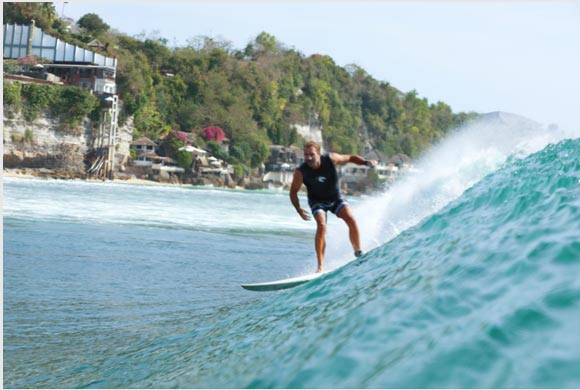SURFBOARD DESIGN 101

SURFBOARD DESIGN 101
Surfboard shaping and design have both changed significantly over the last few decades. Shaping trends are constantly changing. In the seventies, the twin-fin fish began to dominate line ups. Surfers were completely enthralled by the newfound speed and maneuverability of a shorter board. In the eighties, the thruster was designed and changed performance surfing forever. In the nineties and into the new millennium, high-performance boards were long, thin, and completely rockered out for maximum maneuverability. Today, high-performance boards are getting shorter and fatter with an increased focus on the volume under the chest. But what do all these design features really do? How does a board with low entry rocker compare to one with plenty of rocker when you’re actually surfing? What’s the difference in feel between a single fin, a twin fin, a thruster, and a quad? If you’ve ever wanted to know the ins and outs of surfboard design, you are in the right place. From design to function, this article explores all the intricacies of board design 
SURFBOARD LENGTH
Length is a pretty intuitive design feature. The length is the measure of the surfboard from the tip of the nose to the tail. But there is more to length than one might think. Just a few inches taken or added to a board will create a noticeably different ride. The basic school of thought when it comes to length is that the more length a board has, the easier it will be to catch waves. Surfers may ride longboards on small days, or when the surf is maxing out, they may opt for larger step-ups and even big wave guns for help paddling into waves that would be otherwise too large and too fast to catch.
SURFBOARD WIDTH
Width is the measurement of a surfboard across the board at its widest point. Width plays a role in a few different aspects of surfing. The more surface area a board has, the more it will float, the easier it is to paddle, and the easier it is to catch waves. One way shapers achieve this increased surface area without adding length to a board is by increasing width. Small wave grovelers often feature wide tails; this allows surfers to catch more waves. A board with a wide nose might do well in small surf, but it struggles in large surf with steep faces because a narrow nose allows for a steep drop.
TAIL
The tail is the back end of the surfboard. Its shape and thickness directly affect the performance of the board on a wave. The shape of the tail either allows the board to maintain hold on a wave’s face through a turn or release quickly. For example, a rounded tail can hold, but a tail with a wing feature or a swallow tail releases the board from the waves face.

SURFBOARD RAILS
Rails are the edges of the board. Rails affect boards speed, planning ability, and tube riding ability. Thick rails, for example, will plane well and allow for a lot of speed. A hard, low rail has plenty of hold to the waves face, perfect for a good tube riding.
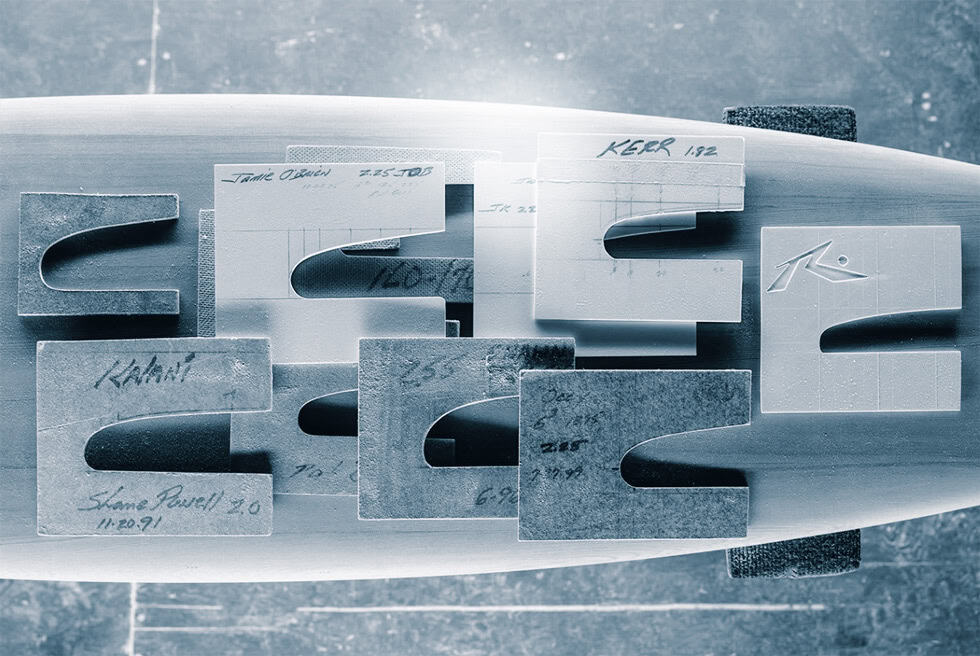
ROCKER
Rocker is a term that refers to the curvature of the board. A dramatic, heavy, or steep rocker will be more curved, while a flat rocker will be less curved. A steep rocker at the nose of the board allows the surfer to take steep drops. Contrastingly, a board that has a steep tail rocker or a steep rocker for the length of the board allows the surfer more manoeuvrability because the board has fewer contact points on a wave and therefore, less drag. High-performance boards often have intricate rockers that allow surfers to perform in steep, dynamic surf. Small wave boards often have flat rockers allowing the board to plane and maintain speed through slow sections of the wave.

BOTTOM CONTOURS
Often overlooked, but crucial factor that plays a significant role in the performance of a surfboard is the bottom contour.
These seemingly minor variations on the underside of the surfboard significantly impact how the board interacts with the water, affecting the ride’s speed, stability, and manoeuvrability.
The concept revolves around hydrodynamics, the branch of physics concerned with the force exerted by or on liquids in motion.
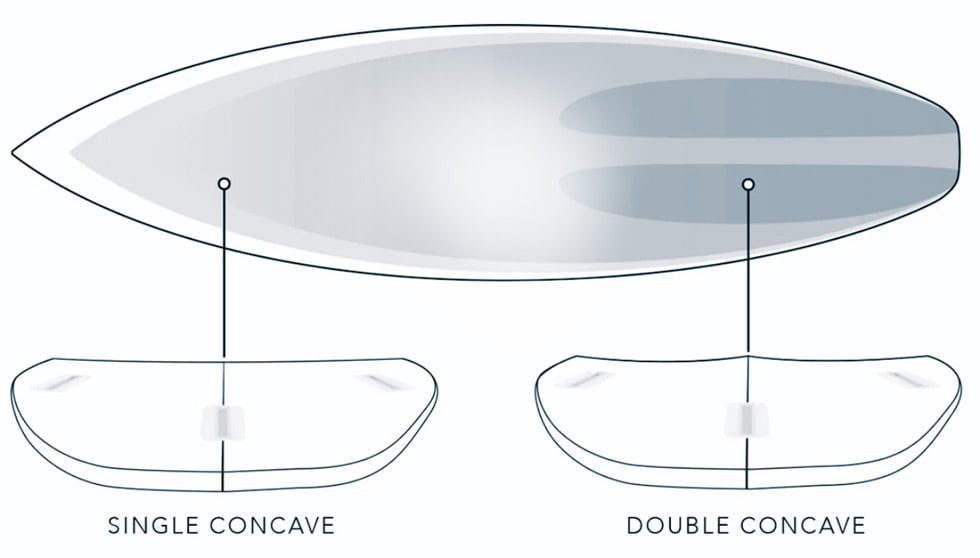
SURFBOARD VOLUME
Importance of Correct Surfboard Volume
Selecting the appropriate surfboard volume is essential for maximizing performance and manoeuvrability in the water. The right volume not only improves your surfing experience but also guarantees suitability for various wave conditions, enabling you to handle different types of waves effortlessly.
Moreover, comprehending the significance of the appropriate surfboard volume customized to your weight, experience level, and surf conditions is fundamental for a successful and enjoyable surfing session.
Impact on performance
The size of a surfboard significantly impacts its functionality in water. High-volume boards, excellent for gaining speed and catching waves with ease, often limit swiftness and make sharp turns difficult.
They are suitable for beginners or those surfing smaller, less forceful waves. Conversely, seasoned surfers frequently favour low-volume boards for handling large waves or performing exact manoeuvres.
These boards provide superior control and permit steeper drop-ins but necessitate more expertise to paddle and catch waves.
Concrete data from tracking devices installed in surfboards provide clarity: there is an optimal balance between size and performance adjusted to each surfer’s weight, skill level, and the wave conditions they aim to master.
Insufficient size leads to sinking, making even the starting difficult; excess can leave a surfer grappling with a board that feels cumbersome and hard to control. Whether opting for longboards that effortlessly slide across small swells or shortboards for rapid turns on large wave days, choosing the correct size is crucial for any surfer wishing to optimize their time in the water.
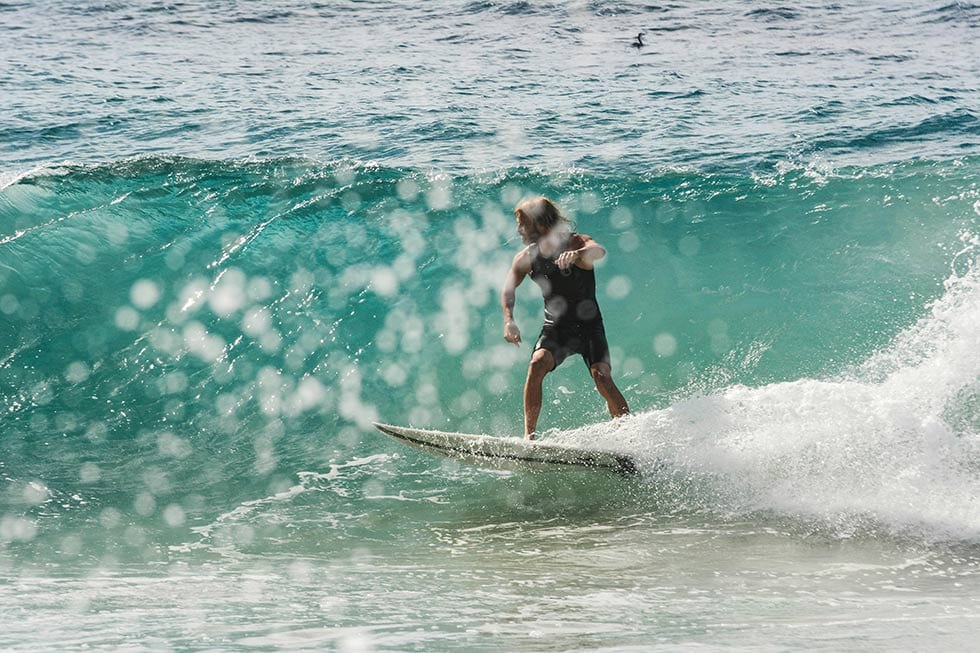
Suitability for different wave conditions
Choosing the right surfboard volume greatly depends on the wave conditions you’ll be surfing in. For smaller waves, opt for boards with more litres to increase speed and glide. This bit of extra volume helps maintain momentum when the power from the ocean isn’t as strong.
On large days, however, surfers should switch to boards with less volume. These sleeker designs provide greater manoeuvrability, allowing for sharp turns and snap on powerful waves without losing control.
In extreme conditions like XXL waves, which require both paddle power and stability, selecting a board with a higher volume becomes essential again. Adjusting your board’s volume according to these guidelines can transform your surfing experience.
Adding roughly 3 liters to your board’s volume can make all the difference in small-wave performance by helping catch more waves easier; whereas reducing volume enhances handling in heavy swells.
How to Calculate Your Ideal Surfboard Volume
When determining your ideal surfboard volume, take into account your weight, experience level, and the wave conditions you’ll be surfing in. These elements are essential in finding the appropriate volume that will optimize your performance and enjoyment on the waves. Utilize online volume calculators to gain thorough understanding of the particular needs for various types of surfboards customized to suit you.
Factors like weight, experience level, and surf conditions
Assessing your optimal surfboard volume begins with comprehension of three vital factors: weight, skill level, and the wave conditions you aim to tackle. These components aid in deciding not just about your comfort and steadiness on the water, but also enhance your competence and advancement as a surfer.
- Weight: More weighty surfers need surfboards with a greater volume to keep afloat. For instance, novices can start looking for boards where the volume is equal to 100% of their body weight in kilograms. As you advance to an expert rank, this requirement modifies to a board volume that extends from 30-40% of your body weight. Such a calculated activity certifies that the board backs you sufficiently without affecting maneuverability.
- Experience Level: Your skills largely impact the volume of surfboard you require. Novices gain from extra volume as it provides increased steadiness and simpler wave catching. Typically, their boards have volumes similar to their complete body weight in liters to simplify paddling into waves and making standing up more achievable. Conversely, adept surfers can manage boards with a lesser volume—around 30-40% of their body weight in liters—permitting for sharper turns and superior control in high-performance surfing situations.
- Surf Conditions: The magnitude and force of the waves you aim to tackle are defining factors in selecting the suitable surfboard volume. Boards that are larger with higher volumes are recommended for smaller or weaker waves as they simplify catching such waves earlier. On the other hand, substantial wave conditions suggest a reduction in volume for desirable speed control and manoeuvrability. This adapted strategy lets surfers optimize their experience based on wave conditions, assuring they have the right equipment for both relaxed cruises on small swells and challenging rides on colossal waves.
By meticulously considering these three aspects – weight, skill level, and wave conditions – you prepare yourself for triumph on the water. Whether opting for a funboard for its lenient nature or accepting big wave guns for exciting rides, understanding how each component impacts your surfboard’s performance is vital to your growth as a surfer.
Examples of Volume Calculations
Calculating the ideal volume for your surfboard is crucial for optimal performance in various wave conditions. Consider factors like weight, experience level, and surf conditions when determining the right size for you.
Understanding the volume requirements based on these elements can significantly enhance your surfing experience. Read our comprehensive guide to find out more about calculating your perfect surfboard volume.
Different surfboard types and their typical volume ranges
Understanding the right surfboard volume for your needs is crucial. It changes how you catch waves, your speed, and your ability to perform tricks. Here’s a quick look at various surfboard types and their typical volume ranges. This guide aims to help you make an informed choice.
| Surfboard Type | Volume Range (liters) |
|---|---|
| Shortboard | 22-35 |
| Fish | 25-45 |
| Funboard | 40-60 |
| Longboard | 60-100 |
Shortboards, known for their agility, fall within a 22-35 liters volume range. They’re best for experienced surfers who want sharp turns and control on steep waves. Fish surfboards, offering a bit more volume at 25-45 liters, cater to those looking for a balance between speed and manoeuvrability. Funboards, with their 40-60 liters volume, suit beginners well, offering ease of catching waves and stability. Longboards have the highest volume, ranging from 60-100 liters, ideal for surfers who prioritize wave-catching ability and a smoother ride over sharp manoeuvres.
Each surfboard type caters to different skill levels and wave conditions. Choose wisely to enhance your surfing experience.

SURFBOARD FINS
Fins propel the board forward, dictate the turning radius, create hold on a waves face, and much more. So obviously, fin set up directly affects the board’s performance and feel. While there are a few novelty few setups that have gone in and out of fashion over the years, such as the bonzer or the asymmetrical setup, there are four standard fin setups: single fin, thruster, twin fin, and quad.
THRUSTER
The thruster (3 fins) is, perhaps, today’s most common fin set-up. When the thruster first appeared on the scene during the 1980s, most surfers were riding twin fins that offered a lot of speed, but not much manoeuvrability. The addition of the back fin provided surfers enough control to be able to turn on a dime. The thruster set-up allows surfers to change direction with ease and carve out massive turns on an open face. This increased manoeuvrability completely changed progressive surfing and brought about the power surfing style that was popularized in the ’90s.

TWIN FIN
The twin fin came into popularity during the 1970s with the rise of “the fish.” These unique shortboards, with two fins placed far apart, allowed surfers to reduce drag and increase speed. Twin fins are ideal, and a blast, in small to medium waves where they provide optimal maneuverability and flow.
QUAD
The Quad fin set up (4 fins) leans heavily on the basic science behind the twin fin, a wide space between fins for water to flow equals speed. However, the extra two fins on the quad provide additional hold, which comes in handy in smaller waves.
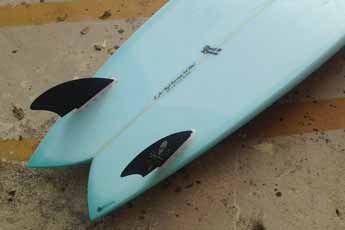
Quads with the trailer fin closer to the rails and further up on the board, perform great on smaller waves, like a twin fin but with a bit more control.
Quads with the trailer fins further back provide extra hold in large hollow barrels, without sacrificing speed.
SINGLE FIN
 Today, most single-fin surfboards are longboards, but that wasn’t always the case.
Today, most single-fin surfboards are longboards, but that wasn’t always the case.
Single fins offer surfers long, drawn-out, arching turns. The one large fin offers plenty of hold but does not have the manoeuvrability of a board with three fins, regardless of the board’s length.
MORE INFO ABOUT SURFBOARDS, SHAPES AND DESIGNS:
– The Swell article surfboard shapes give you more insight into the different types of shapes. – New to surfing? Read the beginners surfboard guide. – What is needed to get you into this? Read the surf equipment and accessories page. – Don’t want to bring your surfboard to Cabarete? See our list of surfboards for rent in Cabarete
ABOUT SWELL
Teaching people the sport of surfing in a safe, quick and fun way is what we specialise in at Swell Surf Camp. We have taught 1000’s of people the basics of surfing.  Learn to surf in the Caribbean with us Interested in changing your life to see the health benefits of learning to surf at our surf retreat?
Learn to surf in the Caribbean with us Interested in changing your life to see the health benefits of learning to surf at our surf retreat?
-
WHERE IS SWELL LOCATED?
Swell Surf camp is located on the North coast of the Dominican Republic, right in the center of the cool surfer town of Cabarete. With 3 international airports to choose from it's also one of the easiest places to get to for a quick surf getaway. Puerto Plata Airport is only 25 minutes away from Swell. On the' getting here' page you'll find the different options of getting to us.
-
ABOUT SWELL SURF CAMP
Founded in the winter of 2009, Swell Surf Camp emerged from Jeroen and Clare Mutsaars vision. They lived in the Dominican Republic for eight years and spotted a gap in the surf camp market for higher quality accommodations combined with an engaging social atmosphere. Their extensive travel and stay experiences across different countries like Costa Rica, Nicaragua, Peru, Hawaii, Indonesia and various European nations fueled their passion to elevate the surfing retreat experience.
Swell Surf Camp is renowned as the world’s first luxury surf camp tailored specifically for beginners. The founders collaborated with a notable Swiss architect to design facilities that blend comfort with style. This innovative approach ensures every guest enjoys superior lodging and amenities. Since its inception, Swell has taught over 9,000 people how to surf with an emphasis on safety, fun, and structure.
Our achievements speak volumes. Swell has collected numerous accolades and maintains hundreds of stellar reviews from guests globally. Recognized repeatedly as the leading destination for luxury surf vacations, our commitment to excellence keeps us at the forefront of the industry.
Beyond surfing, Swell offers a diverse range of activities including kitesurfing, wingfoiling, and yoga classes. Guests can also enjoy horse riding both on scenic beaches and mountain trails—plus exciting adventure-filled excursions like canyoning.
A crucial element of any vacation is food, and here at Swell we excel. We provide delicious home-cooked meals daily. For evenings out, guests find themselves just minutes away from an array of dining options that promise satisfying culinary adventures.
For those who prioritize upscale amenities and wellness in a unique setting built around learning surf skills amid profound natural beauty, Swell should be on the top of your surf destination list
-
WHAT TO EXPECT FROM A 1 WEEK LEARN TO SURF HOLIDAY
Dreaming of catching your first wave but wondering if surf lessons are really for you? At Swell Surf Camp, our lessons are designed specifically for beginners, and we mean absolute beginners, particularly those between 40 and 55 from cities like New York, Boston, or Toronto. You’ll never feel rushed, lost, or out of place. Our expert instructors genuinely love teaching, and their approach is as much about encouragement as it is about skill-building. Every instructor carefully tunes each lesson to fit one person, you, so you always get personalized support, whether you’re working on basic paddling, learning to pop up, or building confidence in the water.
The journey at Swell Surf Camp is about progression, not perfection. You’ll start with the very basics, practicing on the sand before moving into gentle ocean waves with your instructor right beside you. Throughout every lesson, our focus is on clear communication, safety, and keeping things fun. As you progress, our instructors give you feedback in real-time, helping you celebrate small wins and guiding your next steps. You’ll learn solid surfing foundations, water safety, and even the unwritten rules of surf culture. By the end of your stay, you’ll be amazed at your own growth and how natural surfing feels. Don’t wait to discover how transformative a single lesson can be, book your surf adventure at Swell Surf Camp and let your surfing journey begin!
-
WHAT SPORTS DOES SWELL OFFER?
It's not only surfing that's on offer at Swell, we also offer learn to wingfoil and learn to kitesurf packages.
